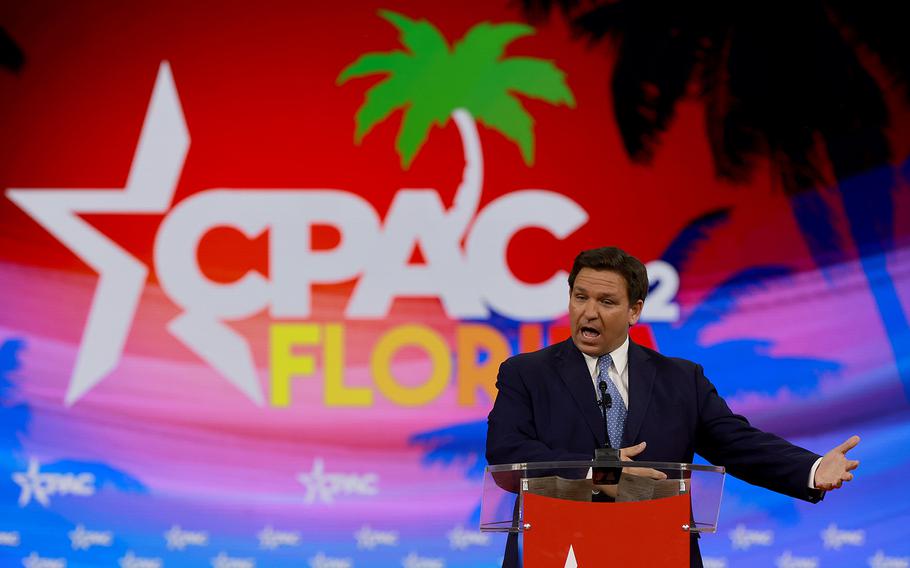
Florida Gov. Ron DeSantis speaks at the Conservative Political Action Conference at The Rosen Shingle Creek on Feb. 24, 2022, in Orlando, Fla. (Joe Raedle, Getty Images/TNS)
In U.S. politics, domestic issues tend to fall into one of two categories: economic or cultural. But it’s getting harder these days to decide where education belongs. That’s because Democrats and Republicans are talking about the issue differently — and their rhetorical dissimilarity shows how each party has adopted its own view of class conflict.
For most Democrats, education has always been largely about dollars and cents. The party’s current policy proposals emphasize increased government funding to improve public schools’ facilities and resources, expand pre-K programs and increase college affordability. President Joe Biden’s plan to forgive certain federal student loan debts, announced shortly before the 2022 midterms but now facing multiple legal challenges, represents a benefit directed toward a specific population — current students and younger graduates — that Democratic leaders view as an important constituency motivated by material self-interest.
Republicans, in contrast, have become more likely to regard education as part of a larger cultural conflict. They describe public schools and universities as liberal-dominated environments that need to be prevented from forcing their ideological vision on U.S. society. Former President Donald Trump introduced an education reform proposal last month that includes cuts in federal funding for schools that teach “critical race theory, gender ideology, or other inappropriate racial, sexual, or political content”; a certification program for teachers who “embrace patriotic values”; and a plan to allow parents the right to elect the principal of their children’s school.
“Our public schools have been taken over by the radical left maniacs,” Trump says in a campaign video announcing his plan. “If we have pink-haired communists teaching our kids, we have a major problem.”
Trump’s recent focus on this issue seems like a response to Florida Gov. Ron DeSantis, a potential rival for the 2024 Republican presidential nomination, who has made the state educational system a primary target in his well-publicized “war on wokeness.” DeSantis has enacted a series of laws in Florida premised on his belief that the state’s public schools and universities have become focused on “the imposition of trendy [left-wing] ideologies,” especially on topics like race and gender. He recently appointed six conservative trustees to oversee the New College of Florida, the state’s honors college, with the goal of reforming its curriculum and policies to be less objectionable to the cultural right.
The parties’ ways of discussing education reflect a larger difference in how they perceive social relations in America. For Democrats, the class system is defined by inequality of wealth, and government-funded education programs are a way for the economically disadvantaged to climb the ladder of success. In his State of the Union address last week, Biden vowed to make the educational system “an affordable ticket to the middle class” and proposed two years of tuition-free community college as a way to expand access to “the best career training in America.” Like many Democrats before him, Biden seeks the support of working-class voters by claiming that his party’s education platform will provide them with the opportunity for upward economic mobility.
For Republicans, the important class distinction is not between the economic haves and have-nots, but between those with more cultural power and those with less. Republican leaders make their own populist appeals to blue-collar voters by targeting institutions led by well-educated, socially progressive professionals — increasingly including the educational system itself.
“In the radical left’s America … our children are taught to hate one another on account of their race, but not to love one another or our great country,” argued Arkansas Gov. Sarah Huckabee Sanders in her State of the Union response. “We are under attack in a left-wing culture war we didn’t start and never wanted to fight.”
Neither party’s vision consistently prevails over the other. The growing salience of cultural concerns has led white Americans without a college degree to support Republican candidates by a 2-to-1 margin in recent elections. Republican voters also hold increasingly negative opinions of U.S. higher education.
Yet rates of educational attainment continue to rise as Americans perceive that staying in school will provide them with a greater economic return after they graduate, and politicians who propose cuts to education spending risk facing a popular backlash even in conservative constituencies. In fact, despite their sharp criticisms of public educators, both DeSantis and Huckabee Sanders have recently proposed increasing teacher salaries and other education funding in their home states.
The struggle over how to frame education policy will continue as long as voters see some truth in how both parties view the class divide in America.
David A. Hopkins is an associate professor of political science at Boston College and the author of “Red Fighting Blue: How Geography and Electoral Rules Polarize American Politics.” This column does not necessarily reflect the opinion of the editorial board or Bloomberg LP and its owners.
©2023 Bloomberg L.P.
Visit bloomberg.com/opinion.
Distributed by Tribune Content Agency, LLC.